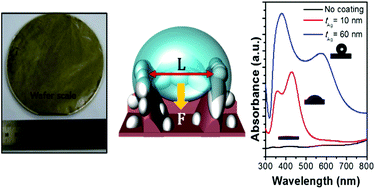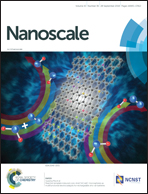Superhydrophobic plasmonic nanoarchitectures based on aluminum hydroxide nanotemplates†
Abstract
The combined characteristics of non-wettabililty and strong plasmonic resonances make superhydrophobic plasmonic nanostructures an appealing tool for ultrasensitive detection in surface-enhanced Raman scattering (SERS). However, inducing superhydrophobic surfaces on originally hydrophilic metals (e.g., gold, silver) while achieving high plasmonic enhancement requires sophisticated surface engineering and often involves complex fabrication processes. In this article, we design and fabricate cost effective and scalable plasmonic nanostructures with both superhydrophobicity (a water contact angle >160°) and high SERS signal (enhancement factor ≈106). Silver-coated aluminum hydroxide nanotemplates are obtained from a simple wet process, followed by thermal evaporation of silver nanoparticles. We find that the largest SERS enhancement is obtained when the contact angle is maximum. This confirms that the control of surface wettability is an effective way to improve detection sensitivity in SERS measurements. The nanotemplates developed in this study could be applied further in various applications, including microfluidic biomolecular optical sensors, photocatalysts, and optoelectronic devices.



 Please wait while we load your content...
Please wait while we load your content...